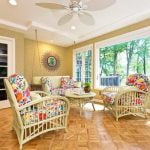Gray has been a dominant color in home decor trends for several years, but is it still as popular as it once was? In this article, we will explore the rise of gray in interior design and its versatility in modern home interiors. We will also discuss whether gray is still relevant in contemporary interior design and explore alternative color trends that may be replacing it.
The use of gray in home decor has soared in recent years, becoming a go-to choice for interior designers and homeowners alike. Its neutral and sophisticated appeal has made it a versatile option for various design styles, from modern to traditional. This rise of gray has been evident in paint colors, furniture, and decor accessories, making it a staple in the world of interior design.
One of the key factors behind the popularity of gray is its adaptability and ability to complement virtually any color scheme. From soft pastels to bold jewel tones, gray serves as an excellent backdrop that allows other colors to shine.
Its understated elegance adds a timeless quality to any space, making it a popular choice for those seeking a classic yet modern aesthetic. Despite its widespread use and popularity, many are now questioning whether gray is still at the forefront of home decor trends or if new color palettes are taking over.
The Versatility of Gray in Interior Design
Gray has been a popular choice in interior design for quite some time now, and its versatility is a major reason for its widespread popularity. From light shades like dove gray to darker hues such as charcoal, gray can be easily incorporated into any home decor style. Whether you prefer a modern, minimalist look or a more traditional and classic aesthetic, gray can work seamlessly with any design preference.
One of the reasons why gray is so versatile in interior design is its ability to pair well with a wide range of colors. Whether it’s complementing other neutral tones, creating contrast with brighter accents, or even blending in with metallic finishes, gray provides a neutral backdrop that allows other colors and elements to stand out.
This flexibility makes it easy for homeowners to experiment with different color palettes and decorative styles without having to worry about clashing with their existing gray decor.
Another aspect of gray’s versatility in interior design is its adaptability to various rooms within a home. From living rooms and bedrooms to kitchens and bathrooms, gray can be used in different ways – whether it’s through wall paint, furniture upholstery, or decorative accessories. Its chameleon-like quality allows gray to set the mood for each room, whether it’s creating a cozy atmosphere or adding an air of sophistication.
| Reasons for Gray’s Versatility | Examples |
|---|---|
| Ability to pair well with a wide range of colors | Complementing other neutral tones |
| Adaptability to various rooms within a home | From living rooms and bedrooms to kitchens and bathrooms |
As much as there are new color trends emerging in home decor, the versatility of gray remains relevant in interior design. Its timeless appeal continues to make it a go-to option for homeowners looking for a color that can effortlessly adapt to ever-changing decor trends. Gray isn’t going out of style anytime soon; rather, it continues to evolve as an integral part of contemporary interior design concepts.
How Gray Has Dominated Home Decor Trends
Gray has been a dominant color in home decor trends for the past decade, and its popularity shows no sign of slowing down. Its neutral and versatile nature makes it a perfect choice for interior design, appealing to a wide range of homeowners and designers. From walls to furniture, accessories to flooring, gray has infiltrated every aspect of home decor.
Here are some reasons why gray has been so prevalent in home decor trends:
- Neutral Base: Gray serves as an excellent neutral base for a variety of color schemes and design styles. It complements both warm and cool tones, making it easy to pair with different accent colors.
- Timeless Elegance: The understated elegance of gray adds a sophisticated touch to any space. Whether used in traditional or contemporary interiors, gray brings a sense of refinement and grace.
- Flexibility: Gray comes in various shades and undertones, allowing for endless possibilities in interior design. From light and airy grays to dark and moody charcoals, there’s a shade of gray that suits every aesthetic.
Despite its current popularity, some may wonder if gray is on its way out in home decor trends. While new color trends are emerging, gray still holds its own in the world of interior design. Its enduring appeal continues to make it a go-to choice for many homeowners and decorators alike.
As we navigate through changing design trends and preferences, it’s important to acknowledge the impact that gray has had on home decor over the years. Regardless of what future color trends may bring, there’s no denying that gray has left an indelible mark on the world of interior design.
The Elegance of Gray in Modern Home Interiors
Gray has long been associated with elegance and sophistication in modern home interiors. Its versatility and ability to complement a wide range of color schemes have made it a popular choice for many homeowners and interior designers. Whether used as the main color or as an accent, gray adds a touch of refinement to any living space.
The Neutral Elegance of Gray
One of the reasons why gray has been so dominant in modern home interiors is its neutral appeal. Unlike bolder colors, gray provides a sense of calm and serenity, making it the perfect canvas for creating a soothing and elegant ambiance. This neutrality allows for easy pairing with other colors, patterns, and textures, making it a versatile choice for any design style.
Gray’s Timeless Appeal
Another factor that contributes to the elegance of gray in modern home interiors is its timeless nature. While certain trends may come and go, gray has proven to stand the test of time. Its classic allure makes it a safe choice for those who want a long-lasting color scheme that won’t go out of style. This enduring quality is especially appealing when considering the investment in home decor and design.
Creating Drama With Gray
In addition to its elegance, gray also has the ability to create drama within a space. Darker shades of gray can add depth and richness to a room, while lighter shades can enhance natural light and lend an airy feel to the environment. The contrast between light and dark grays can also be used to create visual interest and add dimension to interior design schemes.
Despite current trends leaning towards warmer tones such as beige, taupe, and terracotta as well as cooler tones like blues and greens gaining popularity, the elegance and timeless appeal of gray continue to hold its ground in modern home interiors.
Is Gray Still Relevant in Contemporary Interior Design?
Gray has been a dominant color in home decor for many years, but the question remains: is gray still relevant in contemporary interior design? While some may argue that gray has become too overused and predictable, others believe that it still holds its place as a timeless and versatile hue in the world of design.
Let’s take a closer look at how gray is faring in today’s interior design trends and whether it continues to make an impact in modern homes.
The Role of Gray in Contemporary Interior Design
In recent years, there has been a shift towards warmer tones and bolder colors in interior design. However, this does not mean that gray has completely fallen out of favor. In fact, many interior designers are finding creative ways to incorporate gray into contemporary spaces by utilizing different shades and undertones to create unique and stylish looks. Gray still serves as a sophisticated backdrop for other elements in a room, allowing furniture pieces, artwork, and accessories to stand out.
Modern Interpretations of Gray
One of the reasons why gray continues to be relevant in contemporary interior design is its ability to adapt to different styles and aesthetics. From sleek and minimalist spaces to cozy and rustic interiors, gray can be used in various contexts to create diverse atmospheres.
Moreover, modern interpretations of gray often combine this color with contrasting hues or textures to add depth and visual interest to a room. This versatility allows homeowners and designers to experiment with different color palettes while still incorporating gray into their decor.
Embracing New Color Trends Without Abandoning Gray
While new color trends may come and go, it doesn’t necessarily mean that gray needs to be replaced entirely. Instead, it can be complemented by emerging hues such as earthy greens, warm terracottas, or rich blues to create a balanced and contemporary look.
By embracing new color trends without abandoning gray altogether, homeowners can achieve a fresh and updated aesthetic while still maintaining the classic appeal of this timeless hue. Overall, gray continues to hold its own in contemporary interior design by offering flexibility, sophistication, and enduring elegance.
Alternative Color Trends to Replace Gray in Home Decor
Gray has long been a favorite color in home decor, with its neutral and sophisticated appeal. However, as interior design trends continue to evolve, the question of whether gray is going out of style in home decor is becoming more prominent. With new color trends emerging, homeowners are now considering alternative options to replace gray in their home interiors.
One reason why gray has been so popular in home decor is its versatility. It can be used as a base color for almost any interior design style, from modern and minimalist to classic and traditional. However, as more vibrant and bold colors gain traction in the world of interior design, the dominance of gray is being challenged.
One alternative color trend that is gaining momentum in home decor is the use of earthy tones such as terracotta, olive green, and deep mustard yellow. These warm and natural hues are being embraced for their ability to bring a sense of coziness and organic beauty into living spaces.
Additionally, jewel tones like emerald green, sapphire blue, and amethyst purple are making a statement in contemporary interiors, providing a rich and luxurious touch that may not always be achieved with gray.
| Color Trend | Description |
|---|---|
| Earthy Tones | Include terracotta, olive green, and deep mustard yellow; bring coziness and organic beauty into living spaces. |
| Jewel Tones | Comprise emerald green, sapphire blue, and amethyst purple; provide a rich and luxurious touch to contemporary interiors. |
Gray vs New Color Trends
Gray has been a dominant color in home decor for many years, but now, a shift is occurring in interior design trends. The rise of alternative color trends is challenging the reign of gray in modern homes. Let’s take a look at how gray compares to these new color trends in home decor:
- Neutrals: Neutral colors such as beige, ivory, and taupe are making a comeback in contemporary interior design. These soft and warm hues create a welcoming and cozy ambiance in any space.
- Earthy Tones: Earthy tones like terracotta, olive green, and mustard yellow are gaining popularity in home decor. These rich and natural colors bring warmth and depth to interiors, providing a refreshing change from the coolness of gray.
- Jewel Tones: Deep and luxurious jewel tones like emerald green, sapphire blue, and amethyst purple are becoming prominent choices for adding a touch of opulence to home decor. These vibrant hues add drama and sophistication to any room.
As we compare these new color trends to the classic gray, it’s evident that there is a shift towards embracing warmer, more vibrant, and bold hues in contemporary interior design. While gray remains a versatile and timeless choice for home decor, alternative color trends offer an opportunity to infuse personality and character into living spaces. However, it’s essential to consider individual preferences, existing furnishings, and the desired ambiance when selecting the perfect color scheme for any home.
The Timelessness of Gray in Home Decor Trends
In conclusion, while there may be emerging color trends in home decor, it is undeniable that gray has solidified its place as a timeless and classic choice for interior design. The rise of gray in home decor has been attributed to its versatility, elegance, and ability to complement a wide range of styles and palettes. From modern minimalist interiors to cozy rustic spaces, gray has been the go-to color for many homeowners and designers alike.
The versatility of gray in interior design cannot be overstated. Its neutral and calming nature makes it an excellent backdrop for bold accent colors or statement pieces. Whether used as a wall color, furniture upholstery, or décor accents, gray seamlessly adapts to various design aesthetics and can easily be refreshed with different hues to create new looks over time.
Gray’s dominance in home decor trends speaks volumes about its enduring appeal. Despite the emergence of new color trends, the question “Is gray going out oin home decor?” may seem irrelevant as it has proven its staying power time and time again. As new color trends continue to surface, it is inevitable that some will be drawn to alternative options; however, the timelessness of gray in home decor cannot simply be overlooked or replaced.
Frequently Asked Questions
Is Grey Out of Style 2024?
Predicting trends in fashion and home decor can be challenging, but as of now, grey does not seem to be out of style for 2024. Its versatility and ability to complement other colors make it a timeless choice.
Is Grey Still on Trend for Home Decor?
Grey is still very much on trend for home decor. Its neutral and calming qualities make it a popular choice for walls, furniture, and accents. It pairs well with a variety of colors and styles, making it a versatile option for any home.
What Colour Will Replace Grey?
While it’s difficult to predict with certainty, some color trends suggest that warmer earthy tones like terracotta or olive green could replace grey in the future. These colors bring warmth and depth to a space, providing an alternative to the cool neutrality of grey.

I’m thrilled to be your companion on this exciting journey through the world of home decor and design. With a passion for turning houses into homes and a keen eye for the finer details, I’m here to help you transform your living spaces into beautiful, functional, and meaningful havens.





